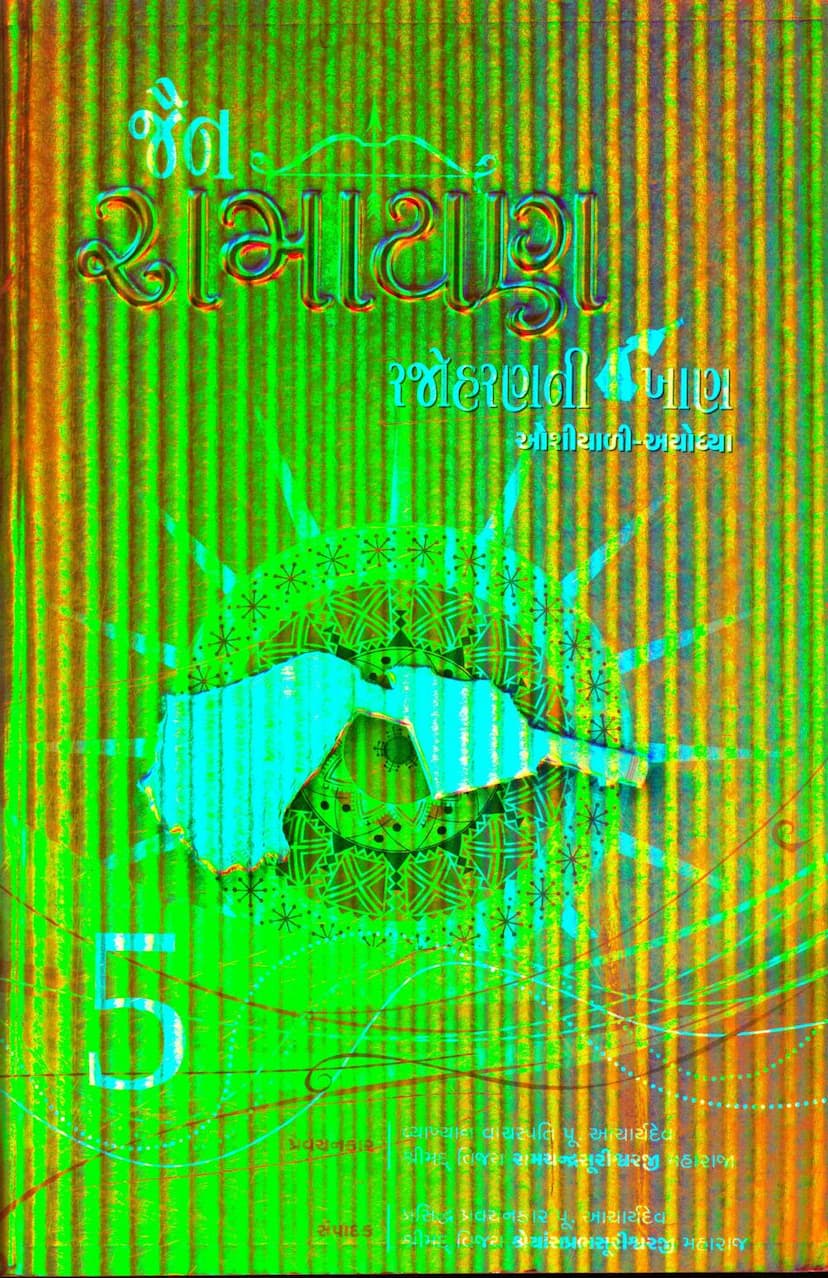Jain Ramayan Part 05
Added to library: September 2, 2025

Summary
Here is a comprehensive summary of the Jain Ramayan Part 05, titled "Oshiayali Ayodhya" (Humble Ayodhya), authored by Acharya Shrimad Vijay Ramchandrasurishwarji Maharaj and edited by Acharya Shrimad Vijay Shreyansprabhsurishwarji Maharaj, published by Smrutimandir Prakashan.
This volume, the fifth in the "Jain Ramayan: A Mine of Sacred Dust" series, delves into specific episodes and philosophical discussions within the Jain interpretation of the Ramayana narrative. The central theme revolves around the exemplary conduct and profound wisdom of key figures, particularly Lord Ram and his devoted follower Vibhishana, as well as Lord Rama's brother Lakshmana and the noble Prince Bharata.
Key Themes and Highlights:
-
Vibhishana's Devotion and Rama's Detachment: The narrative highlights Vibhishana's unwavering devotion and sincere requests to Lord Rama to accept the kingdom of Lanka. Lord Rama's response is characterized by profound detachment and adherence to his vows, exemplified by his respectful coronation of Vibhishana as king. The text emphasizes Lord Rama's noble character, noting that he was not a demon but a virtuous soul with self-control.
-
Rama's Non-Attachment to Material Possessions: After his victory and reunion with Sita, Lord Rama enters Ravana's palace and is immediately drawn to the presence of Lord Shantinath's idol in a grand temple, finding solace in divine presence rather than worldly riches. This contrasts with the usual portrayal of kings driven by material gain.
-
The Role of the Acharya in Jainism: The text draws a parallel between the king's responsibility for his subjects and the Acharya's role in the Jain tradition. Acharyas are depicted as protectors and guides for the four-fold Jain community (monks, nuns, laymen, and laywomen). Their primary duty is to ensure the spiritual progress and well-being of the community, acting as the "king" of the spiritual realm. The importance of virtuous leadership is stressed, warning against those who become corrupted or misguide the followers.
-
The Character of Prince Bharata: Prince Bharata's profound detachment and renunciation are central to this volume. Despite being the rightful heir and enjoying immense royal fortune, Bharata remains deeply devoted to spiritual pursuits. His contemplation of the ephemeral nature of worldly pleasures, the harsh realities of existence, and the true meaning of renunciation are explored through various analogies. Bharata's unwavering focus on spiritual liberation, even amidst royal grandeur, serves as a powerful example of detachment.
-
The Nature of True Devotion and Attachment: The text delves into the philosophy of devotion, emphasizing that it should be directed towards the Tirthankaras, Acharyas, and the Dharma, rather than worldly possessions or sensual pleasures. It critiques superficial devotion and highlights the importance of inner sincerity and the cultivation of virtues like detachment, equanimity, and self-control.
-
The Significance of Self-Reflection and Detachment: Bharata's internal struggle and his profound contemplation of the illusory nature of worldly happiness are meticulously described. His realization that true happiness lies in spiritual pursuits, not in material possessions or sensual gratifications, is a key takeaway. The text emphasizes the need for self-reflection to understand one's true spiritual goals and to cultivate detachment from worldly affairs.
-
The Dangers of Moha (Attachment/Delusion): The narrative vividly illustrates how attachment (moha) can cloud judgment and lead even noble souls astray. The plight of the characters, even those in positions of power and virtue, underscores the pervasive influence of moha and the constant need for vigilance and spiritual discipline.
-
The Distinction Between True and False Renunciation: The volume touches upon the nuances of renunciation, differentiating between genuine spiritual aspiration and mere outward show. It stresses that true renunciation stems from an inner realization of the suffering inherent in the cycle of birth and death (samsara) and a deep longing for spiritual liberation.
-
The Importance of Knowledge and Right Conduct: The text repeatedly emphasizes the significance of acquiring right knowledge (Samyak Darshan) and practicing right conduct (Samyak Charitra) as the path to spiritual liberation. It highlights that without these, even virtuous actions can be devoid of true spiritual merit.
-
The Role of Youth in Spiritual Pursuit: The teachings suggest that youth is a prime time for spiritual endeavors, as the mind is more receptive and the body is capable of enduring ascetic practices. It contrasts this with the regret that often accompanies old age when opportunities for spiritual growth have been missed.
-
The Interconnectedness of Karma and Destiny: Through various narratives, the text illustrates the Jain doctrine of karma, explaining how past actions influence present circumstances and future destinies. It encourages an understanding of karma's workings to navigate life's challenges with equanimity and spiritual awareness.
-
The Nature of True Service: The concept of service is explored not as a means of gaining favor or reward, but as an act of pure devotion and a path to self-upliftment. The examples provided showcase service driven by genuine love and a desire for the spiritual well-being of both the giver and the receiver.
-
The Critique of Superficiality: The text implicitly and explicitly critiques those who engage in religious practices for outward show or societal approval. It calls for introspection and a genuine commitment to spiritual principles over superficial adherence.
In essence, "Jain Ramayan Part 05: Oshiayali Ayodhya" offers a profound exposition of Jain philosophy through the lens of the Ramayana. It provides guidance on cultivating detachment, understanding the true nature of reality, overcoming worldly attachments, and diligently pursuing the path of spiritual liberation, all while emphasizing the exemplary conduct of revered figures within the Jain tradition.